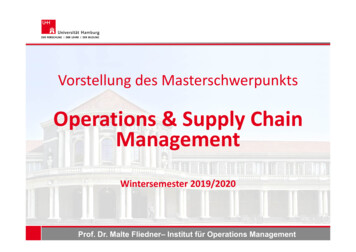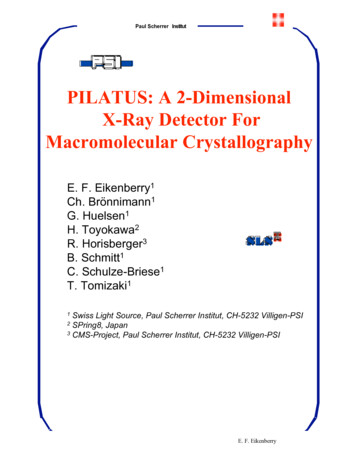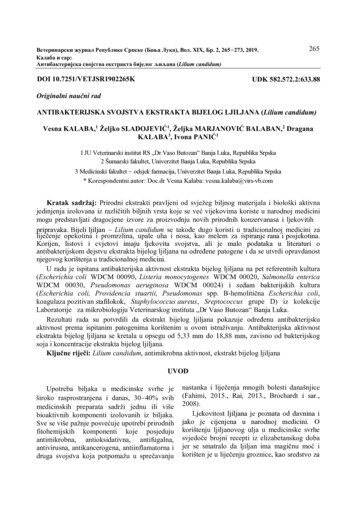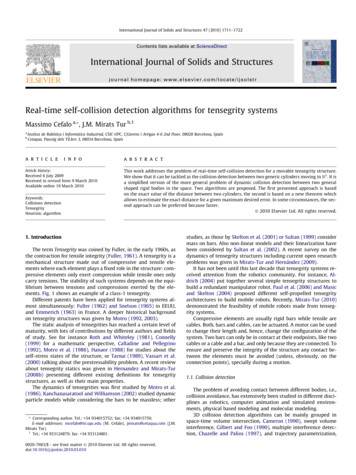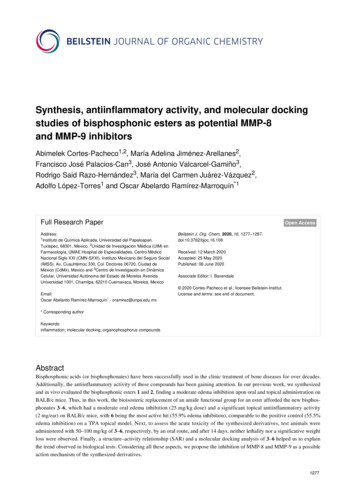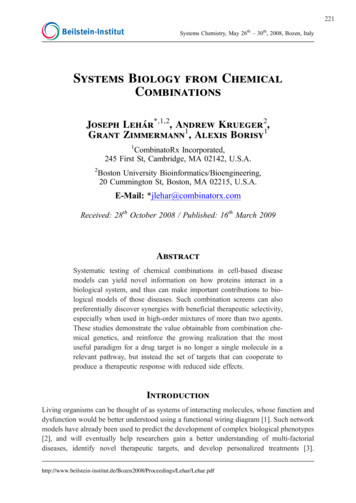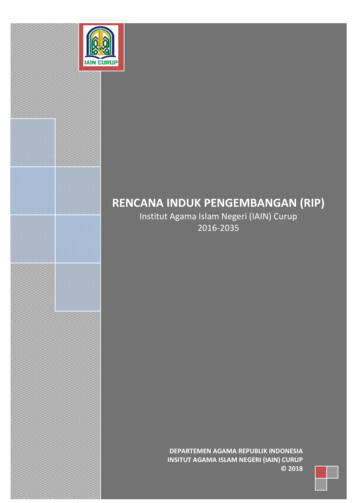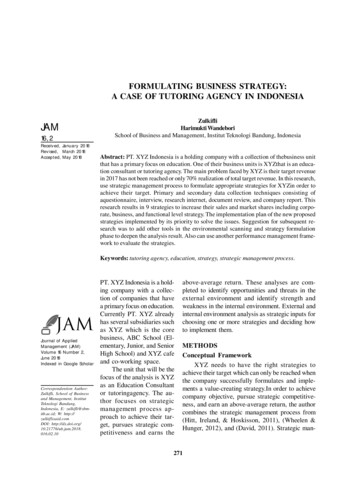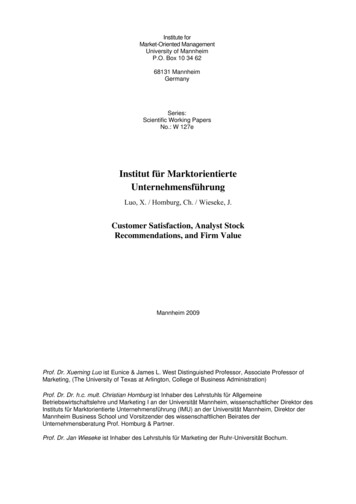
Transcription
Institute forMarket-Oriented ManagementUniversity of MannheimP.O. Box 10 34 6268131 MannheimGermanySeries:Scientific Working PapersNo.: W 127eInstitut für MarktorientierteUnternehmensführungLuo, X. / Homburg, Ch. / Wieseke, J.Customer Satisfaction, Analyst StockRecommendations, and Firm ValueMannheim 2009Prof. Dr. Xueming Luo ist Eunice & James L. West Distinguished Professor, Associate Professor ofMarketing, (The University of Texas at Arlington, College of Business Administration)Prof. Dr. Dr. h.c. mult. Christian Homburg ist Inhaber des Lehrstuhls für AllgemeineBetriebswirtschaftslehre und Marketing I an der Universität Mannheim, wissenschaftlicher Direktor desInstituts für Marktorientierte Unternehmensführung (IMU) an der Universität Mannheim, Direktor derMannheim Business School und Vorsitzender des wissenschaftlichen Beirates derUnternehmensberatung Prof. Homburg & Partner.Prof. Dr. Jan Wieseke ist Inhaber des Lehrstuhls für Marketing der Ruhr-Universität Bochum.
The Institute for Market-Oriented ManagementInstitute for Market-Oriented ManagementThe Institute for Market-Oriented Management (IMU) at the University of Mannheim (Germany)considers itself to be a forum for dialogue between scientific theory and practice. The high scientific andacademic standard is guaranteed by the close networking of the IMU with the three Chairs of Marketingat the University of Mannheim, which are highly renowned on a national and international level. TheAcademic Directors of the IMU areProf. Dr. Hans H. Bauer, Prof. Dr. Dr. h.c. mult. Christian Homburg and Prof. Dr. Sabine Kuester.The IMU offers the following services and expertise:Management Know-HowThe IMU publishes papers geared towards managers in companies. Subjects highly relevant to business practice are presented here in a compact and concise manner, and scientific research results areefficiently communicated. In many cases, these publications are based on application-oriented research and cooperation projects involving a large number of global companies.Scientific Working PapersThe scientific studies conducted by the IMU analyze new trends that have an impact on marketoriented management. On this basis, practice-oriented findings are derived and published in our series ofscientific working papers. Today, many of our publications have been printed in prominent journalsand honored with awards at international conferences (e.g., by the American Marketing Association).Series PublicationIn addition to publishing scientific working papers, the IMU, in cooperation with Gabler publishinghouse, issues a series featuring exemplary scientific findings from the field of market-oriented management.Application-oriented ResearchAt IMU, research aims at generating scientific results that are relevant to market-oriented management. Therefore, the IMU offers you the option of submitting concrete questions arising from yourcompany practice, which are then scientifically analyzed.If you require additional information or have any questions, please contact the Institute for MarketOriented Management, University of Mannheim, L5, 1, 68131 Mannheim, Germany (phone: 49621/ 181-1755) or visit our website at: www.imu-mannheim.com.
The Institute for Market-Oriented ManagementThe work of the IMU is supported by a group of partners comprising:AUDI AG,Peter SchwarzenbauerBASF SE,Hans W. ReinersBremer Landesbank,Dr. Stephan-Andreas KaulversBSH GmbH,Matthias GinthumCarl Zeiss AG,Dr. Rainer OhnheiserCognis Deutschland GmbH & Co. KG,Dr. Jürgen SchererContinental AG,Dr. Hartmut WöhlerCoty GmbHBernd BeetzDeutsche Bank AG,Rainer NeskeDeutsche Messe AG,Ernst RaueDeutsche Post AG,Thomas KippDeutsche Telekom AG,Dr. Christian IllekDürr AG,Ralf W. DieterE.On Energie AG,Dr. Bernhard ReutersbergEvoBus GmbH,Michael GöpfarthFiege Holding Stiftung & Co. KG,Heinz FiegeFocus Magazin Verlag,Frank-Michael MüllerFreudenberg & Co. KG,Jörg SostFuchs Petrolub AG,Stefan FuchsStephan M. HeckHeidelbergCement AG,Andreas KernHeidelberger Druckmaschinen AG,Dr. Jürgen RautertHeraeus Holding GmbH,Jan RinnertIBM Deutschland GmbH,Jörg PetersKabel BW,Christoph NiederKARSTADT Warenhaus GmbH,Stefan HerzbergKnauf Gips KG,Manfred GrundkeProf. Dr. Dr. h.c. Richard KöhlerKörber PaperLink GmbH,Martin WeickenmeierK S AG,Dr. Ralf BethkeL’Oréal Deutschland GmbH,Rolf SigmundMVV Energie AG,Matthias BrückmannNestlé Deutschland AG,n.n.Pfizer Pharma GmbH,Jürgen BraunDr. Volker PfahlertThomas PflugProcter & Gamble GmbH,Willi SchwerdtleDr. h.c. Holger ReichardtHans RiedelRobert Bosch GmbH,Uwe RaschkeRoche Diagnostics GmbH,Jürgen RedmannRoche Pharma AG,Dr. Hagen PfundnerRudolf Wild GmbH & Co. KG,Carsten KaisigRWE Energy AG,Dr. Andreas RadmacherR V Lebensversicherung AG,Heinz-Jürgen KallerhoffSaint-Gobain Building Distribution DeutschlandGmbHUdo H. BrandtThomas SattelbergerSAP Deutschland AG & Co. KGLuka MucicProf. Dr. Dieter ThomaschewskiFH LudwigshafenTRUMPF GmbH & Co. KG,Dr. Mathias KammüllerUnited Internet Media AG,Matthias EhrlichVDMA e.V.,Dr. Hannes HesseVoith AG,Bertram Staudenmaier
The Institute for Market-Oriented ManagementW127e Luo, X. / Homburg, Ch. / Wieseke, J.: Customer Satisfaction, Analyst Stock Recommendations, and Firm Value, 2009W125e Homburg, Ch. / Wieseke, J. / Kuehnl, Ch.: If one Steps out of the Phalanx. Analyzing leaders’ influence on sales forceautomation adoption with a quadratic dataset, 2009W123e Homburg, Ch. / Wieseke, J. / Hoyer, W. D.: Social Identity and the Service Profit Chain, 2008W121e Bauer, H. H. / Falk, T. / Hammerschmidt, M. / Schepers, J. J. L.: New Insights in the Quality-Satisfaction Link. IdentifyingAsymmetric and Dynamic Effects, 2008W120e Bauer, H. H. / Falk, T. / Schepers, J. J. L. / Hammerschmidt, M.: Exploring Cross Channel Dissynergies in MultichannelSystems, 2008W119e Kuester, S. / Hess, S. / Young, J. / Hinkel, J.: Brands as Means of Self-expression: A Cross-cultural Comparison, 2008W117e Bauer, H. H. / Donnevert, T. / Hammerschmidt, M.: Making Brand Management Accountable – The Influence of BrandRelevance, Globalness and Architecture on Brand Efficiency, 2008W116e Wieseke, J. / Ullrich, J. / Christ, O. / van Dick, R.: Organizational Identification as a Determinant of Customer Orientation inService Organizations, 2008W105e Homburg, Ch. / Hoyer, W. / Stock-Homburg, R.: How to get lost customers back? Insights into customer relationship revivalactivities, 2006W104e Homburg, Ch. / Fürst, A.: See No Evil, Hear No Evil, Speak No Evil: A Study of Defensive Organizational Behavior towardsCustomer, 2006W102e Homburg, Ch. / Jensen, O.: The Thought Worlds of Marketing and Sales: Which Differences Make a Difference?, 2006W101e Homburg, Ch. / Luo, X.: Neglected Outcomes of Customer Satisfaction, 2006W094e Bauer, H. H. / Reichardt, T. / Schüle, A.: User Requirements for Location Based Services. An analysis on the basis ofliterature, 2005W091e Homburg, Ch. / Bucerius, M.: Is Speed of Integration really a Success Factor of Mergers and Acquisitions? An Analysis ofthe Role of Internal and External Relatedness, 2006W084e Homburg, Ch. / Kuester, S. / Beutin, N. / Menon, A.: Determinants of Customer Benefits in Business-to-Business Markets:A Cross-Cultural Comparison, 2005W083e Homburg, Ch. / Fürst, A.: How Organizational Complaint Handling Drives Customer Loyalty: An Analysis of the Mechanisticand the Organic Approach, 2005W080e Homburg, Ch. / Bucerius, M.: A Marketing Perspective on Mergers and Acquisitions: How Marketing Integration AffectsPost-Merger Performance, 2004W079e Homburg, Ch. / Koschate, N. / Hoyer, W. D.: Do Satisfied Customers Really Pay More? A Study of the Relationship between Customer Satisfaction and Willingness to Pay, 2004W070e Bauer, H. H. / Mäder, R. / Valtin, A.: The Effects of Brand Renaming on Brand Equity: An Analysis of the Consequences ofBrand Portfolio Consolidations, 2007W068e Homburg, Ch. / Stock, R.: The Link between Salespeople's Job Satisfaction and Customer Satisfaction in a Business-toBusiness Context. A dyadic Analysis, 2003W057e Bauer, H. H. / Hammerschmidt, M. / Staat, M.: Analyzing Product Efficiency. A Customer-Oriented Approach, 2002W055e Homburg, Ch. / Faßnacht, M. / Schneider, J.: Opposites Attract, but Similarity Works. A Study of Interorganizational Similarity in Marketing Channels, 2002W053e Homburg, Ch. / Workman, J. P. / Jensen, O.: A Configurational Perspective on Key Account Management. 2002W036e Homburg, Ch. / Pflesser, Ch.: A Multiple Layer Model of Market-Oriented Organizational Culture. Measurement Issues andPerformance Outcomes., 2000W035e Krohmer, H. / Homburg, Ch. / Workman, J.P.: Should Marketing Be Cross-Funktional? Conceptual Development andInternational Empirical Evidence, 2000W030e Homburg, Ch. / Giering, A. / Menon, A.: Relationship Characteristics as Moderators of the Satisfaction-Loyalty Link. Findings in a Business-to-Business Context, 1999W029e Homburg, Ch. / Giering, A.: Personal Characteristics as Moderators of the Relationship Between Customer Satisfactionand Loyalty. An Empirical Analysis, 1999W021e Homburg, Ch. / Workman, J. P. / Jensen, O.: Fundamental Changes in Marketing Organization. The Movement towardCustomer-focused Organizations, 1998W016e Gruner, K. / Homburg, Ch.: Customer Interaction as a Key to New Product Success, 1998W014e Homburg, Ch. / Krohmer, H. / Workman, J. P.: Performance Impacts of Strategic Consensus. The Role of Strategy Typeand Market-Related Dynamism, 1997W013e Homburg, Ch. / Kiedaisch, I. / Cannon, J. P.: Governance Mechanisms in Transnational Business Relationships, 1997W011e Homburg, Ch. / Workman, J.P. / Krohmer, H.: Marketing’s Influence within the Firm, 1997For more working papers, please visit our website at: www.imu-mannheim.com
Luo / Homburg / WiesekeCustomer Satisfaction, Analyst Stock Recommendations, and Firm ValueABSTRACTAlthough managers are interested in the financial value of customers and researchers pointout the importance of stock analysts who advise investors, no studies seem to have exploredthe implications of customer satisfaction for analyst stock recommendations. On the basis of alarge-scale longitudinal dataset, the authors find that positive changes in customer satisfactionnot only improve analyst recommendations but also lower dispersion in thoserecommendations for the firm. These effects are stronger when product market competition ishigh and financial market uncertainty is large. Also, analyst recommendations at leastpartially mediate the effects of changes in satisfaction on firm abnormal return, systematicrisk, and idiosyncratic risk. Analyst recommendations represent a mechanism through whichcustomer satisfaction affects firm value. Thus, if analysts pay attention to Main Streetcustomer satisfaction, then Wall Street investors should have good reason to listen and follow.Overall, our research reveals satisfaction’s impact on analyst-based outcomes and firm valuemetrics and calls attention to the construct of customer satisfaction as a key intangible assetfor the investor community.Keywords: Customer Satisfaction, Financial Analysts, Competition, Marketing-Finance,Stock Recommendations, Return, Risk
Luo / Homburg / WiesekeCustomer Satisfaction, Analyst Stock Recommendations, and Firm ValueCONTENTS1Introduction . 41.1Background and Hypotheses . 61.2Analyst Stock Recommendations. 71.3Customer Satisfaction and Analyst Stock Recommendations . 91.4The Moderating Role of Product Market Competition and Financial MarketVolatility. 111.523The Mediating Role of Analyst Stock Recommendations . 12Methodology. . 132.1Data . 132.2Measuring Customer Satisfaction . 142.3Measuring Analyst Stock Recommendations . 162.4Measuring Firm Value . 172.5Measuring Control Variables . 182.6Model Specifications . 20Results. . . 223.1Results on the Effect of Customer Satisfaction on Analyst StockRecommendations . 223.2Results on the Moderating Role of Product Market Competition and FinancialMarket Volatility . 2443.3Results on the Mediating Role of Customer Satisfaction . 253.4Customer Satisfaction and Accurate Analyst Forecasts . 27Discussion and Implications . 284.1Research Implications . 294.2Managerial Implications . 313
Luo / Homburg / WiesekeCustomer Satisfaction, Analyst Stock Recommendations, and Firm Value1IntroductionCorporate managers are interested in understanding the financial value of customers andthe relevance of market-based assets to the investor community (Gupta, Lehmann, and Stuart2004; Lehmann and Reibstein 2006; Srinivasan and Hanssens 2009). For example, accordingto Marketing Science Institute reports, linking key marketing metrics to the investorcommunity such as stock analysts represents top-priority issues on CMOs’ agenda(www.MSI.org).Stock analysts (e.g., brokerage firms, banks, or private researchers) play indispensableroles in financial markets as they “gather and process information about a firm and issuerecommendations and forecasts to investors” (Chen and Matsumoto 2006, p. 658). In simplestwords, analysts deliver extra value to investors by (1) analyzing publicly availableinformation more skillfully than general financial market participants, and (2) collectingcostly firm-specific private information that is not available to the public but may signal afirm’s customer base quality and future financial strength (Ivkovic and Jegadeesh 2004;Womack 1996).Indeed, analysts’ stock recommendations are so important that they provide incrementalvalue over accounting profitability. Jegadeesh et al. (2004, p. 1083) document that “change instock recommendations is a robust return predictor that appears to contain information over alarge range of other predictor variables including earnings, growth, valuation multiples, size,trading, and others.” Despite the potential importance of financial analysts as indicated by thefinance and accounting research (Howe, Unlu, and Yan 2009), marketing literature has thusfar neglected to study the impact of key marketing instruments on analysts. (Analogously,finance and accounting research on analysts has thus far neglected marketing constructs.)Nevertheless, marketing scholars echo the theoretical importance of financial analysts. Forexample, Srinivasan and Hanssens (2009, p. 293) emphasize that “investors trade companyshares because their expectations [as gauged by analysts’ recommendations and forecasts] ofthese companies’ future earnings differ The importance of this earning expectation isevident every quarter when companies’ earnings announcements are followed by sometimesdrastic stock price adjustments when the actual earnings deviate from expectations.”Similarly, Kimbrough et al. (2009, p. 318) note that “analysts can provide credible sources ofinformation in aiding investors’ interpretation of firms’ intangible investment.” Other studiesallude to the importance of analysts’ forecasts, surmising that if analysts are doubtful of nonfinancial, off-balance sheet assets, stock recommendations are bound to be deficient (Kim and4
Luo / Homburg / WiesekeCustomer Satisfaction, Analyst Stock Recommendations, and Firm ValueMcAlister 2007; Whitwell, Lukas, and Hill 2007), and the information content of customersatisfaction would be misevaluated by investors (Fornell et al. 2006, p. 11).To our knowledge, there are no published studies across marketing, accounting, andfinance disciplines that have explicitly connected a key marketing construct of customersatisfaction to analysts’ stock recommendations. This research gap is of high importance fortwo key reasons. First, the literature appears to call for research explicitly testing “whethercustomer satisfaction provides information for the Wall Street community such as financialanalysts” (Tuli and Bharadwaj 2009, p. 3). Second, given the information intermediary role ofanalysts in the stock market, analyst recommendations might be one possible channel forstock market reactions to the information content of changes in customer satisfaction. Yet, thenotion of whether stock recommendations may act as a mechanism through which intangibleassets such as customer satisfaction affect firm value has been neglected in the literature.Therefore, our study addresses this gap by investigating the following questions. (1) Arepositive changes in customer satisfaction of a firm related to positive changes in analyst stockrecommendations for the firm? (2) Do positive changes in customer satisfaction result inlower dispersion in stock recommendations? (3) Can these effects on stock recommendationsvary across different situations of product market competition and financial marketuncertainty? And (4) to what extent is customer satisfaction’s possible impact on firm valuechannelled by analyst stock recommendations?The key contributions of this paper are as follows. To the best of our knowledge, we areamong the first to theorize and test financial analysts’ reactions to a core marketing metric ofcustomer satisfaction. Thus, for researchers, we help promote a more complete understandingof the impact of customer satisfaction and activate attention for the construct of customersatisfaction as an important market-based intangible asset for the investor community. Inaddition, we contribute to the nascent research stream on the marketing–finance interface byshowing why financial analysts should track customer satisfaction in forming their stockrecommendations. Interestingly, our study uncovers new mechanisms that explain thefinancial impact of customer satisfaction. That is, stock recommendation might play amediating role between customer satisfaction and firm value.Also, our work extends related studies by Jacobson and Mizik (2007, 2009) in three ways.First, while they examine the direct impact of satisfaction on stock returns (without mediatingeffects), we examine the indirect impact (with mediating effects of recommendations).Second, their work focuses on stock returns in the value-relevance of satisfaction, whereas we5
Luo / Homburg / WiesekeCustomer Satisfaction, Analyst Stock Recommendations, and Firm Valueinvestigate both stock returns and risks (systematic and idiosyncratic) as firm valuationmetrics. Third, while they examine subsample nuances (computer and Internet sector) in thesatisfaction-return link, we examine heterogeneity with moderated effects (product marketcompetition and financial market uncertainty) in the satisfaction-recommendation-value link.Thus, our work complements and advances their studies. By suggesting that recommendationis a channel through which news of satisfaction might reach investors, we reveal reasons forsatisfaction’s impact on firm value largely ignored (Ittner, Larcker, and Taylor 2009; Fornell,Mithas, and Morgeson 2009; O’Sullivan, Hutchinson, and O’Connell 2009).Moreover, our work has important practical implications, especially for marketingmanagers and financial analysts. If a positive link exists between customer satisfaction,analyst recommendation, and firm value, CMOs may better communicate firm competitiveadvantages in terms of customer satisfaction to the Wall Street community. In addition, ourstudy of non-financial information and analyst recommendations directly speaks to theFinancial Accounting Standards Board (FASB). Because firms are required by FASB todisclose non-financial information to investors that help them gauge the growth and volatilityof future cash receipts (Gupta 2009; Kimbrough 2007), our work may encourage firms toproactively announce changes in customer satisfaction to the public and report the size andquality of customer base of the firm in annual reports and SEC 10-K/10-Q filings to the WallStreet community.1.1 Background and HypothesesFigure 1 provides an overview of the relationships in our theoretical framework. Thisframework suggests that (a) changes in customer satisfaction of a firm have an impact onchanges in analyst stock recommendations and dispersion in stock recommendations for thefirm, (b) product market competition and financial market uncertainty moderate the linkbetween customer satisfaction and analyst recommendations, and (c) recommendations atleast partially mediate the relations between customer satisfaction and firm value. In thisframework, customer satisfaction is first related to the intermediate outcome of analyst stockrecommendations, and then to firm value as reflected by stock return and risk.6
Luo / Homburg / WiesekeCustomer Satisfaction, Analyst Stock Recommendations, and Firm ValueFigure 1: Conceptual Framework1.2 Analyst Stock RecommendationsFinancial analysts are information intermediaries between firms and investors. For firms,analysts serve as information disclosure agents. For investors, analysts provide expectationsof firms’ future cash flows. Analysts help reduce the information asymmetry between firmsand investors, and their stock recommendations should influence investors’ buy-hold-selldecisions (Barber et al. 2001). Ivkovic and Jegadeesh (2004) suggest that “the value containedin stock recommendations can broadly be attributed to two sources. First, analysts might beskilled at analyzing the value relevance of public information (more so than generalinvestors). Second, analysts might possess the ability to gather a wide variety of informationnot readily available to investors and to efficiently process that information” (p. 434).Formally, analyst stock recommendations refer to the investment opinion financialanalysts provide to investors regarding whether a given stock is worth buying or selling(Ivkovic and Jegadeesh 2004; Womack 1996). In essence, Wall Street brokerage firmsemploy analysts to examine firm fundamentals, compile public and private information, andpredict the prospects of firm future earnings and investment potential. These predictions formthe basis for issuing specific stock recommendations to investors. The common ratings of theresultant recommendations are “strong buy,” “buy,” “hold,” “under-perform,” and “sell”(from most to least favorable). Thus, analyst stock recommendations capture forward-lookinginformation that helps investors gauge future cash flows and firm value.7
Luo / Homburg / WiesekeCustomer Satisfaction, Analyst Stock Recommendations, and Firm ValueBoth trade press and academic research confirm the importance of analystrecommendations. Investors reward firms with favorable analyst recommendations and punishthose with unfavorable recommendations (Forbes 2009). For example, as stock analystsrelease buy-recommendations for Metalico Inc., a firm specialized in recycling scrap, its stockprice soars on Wall Street (BusinessWeek 2008). For most firms listed in S&P 400, 500, and600 indexes, Goff et al. (2008) report that stock prices generally hike up (decrease) inresponses to upgrades (downgrades) in analyst recommendations. Even during financialcrises, investors who follow analysts’ sell-recommendations suffer fewer losses (Wall StreetJournal 2009).Echoing this, scholarly research in finance and accounting has shown the incrementalvalue of stock recommendations over firm earnings. For instance, pointing out strong andpersistent stock market reactions, Womack (1996, p. 164) finds that that “the stock priceadjusts either up 5% for changes to buy-recommendations or down 11% for changes to sellrecommendations.” Barber, Lehavy, McNicols, and Tureman (2001) support that a strategybased on the highest recommendations can yield an annualized return of 18.8% that issignificantly greater than the broad financial markets. As such, Jegadeesh and Kim (2004, p.1) note that “in spite of any inherent biases, the extant literature finds that analystrecommendations do add value.” In accounting, Howe, Unlu, and Yan (2009) conclude rmationcontent:changesinrecommendations forecast future returns” (p. 1). A more detailed review of studies on analystrecommendations is provided in the web-based Appendix A. Thus, a rich literature suggeststhat analyst recommendations are critical financial metrics to the Wall Street community.Interestingly, anecdotal evidence suggests that real stock analysts may indeed scrutinizeintangibles such as customer satisfaction and reflect this information in theirrecommendations. On the basis of in-depth interviews with 63 analysts from 40 brokeragefirms, Whitwell, Lukas, and Hill (2007) find that analysts pay attention to firm intangiblessuch as customer satisfaction and loyalty, since “such assessment can lead to more reliablevaluations of the firm” (p. 86), and because ignoring intangibles is bound to generate deficientand less credible recommendations. Furthermore, through content analyses of 105recommendation reports, Breton and Taffler (2001) find that after accounting for earnings,“non-financial information factors such as customers- and products-related strategies are themost significant drivers of analyst recommendations, because non-financial informationindicates the quality of corporate management and future cash flow prospects” (p. 91).8
Luo / Homburg / WiesekeCustomer Satisfaction, Analyst Stock Recommendations, and Firm ValueIndeed, prior studies in accounting have shown the importance of intangible R&Dinformation for analysts. Barth, Kasznik and McNichols (2001) find that analysts spend moreefforts to follow firms with higher intangible assets. Barron et al. (2002) show that analystforecast disagreement is also related to firm intangibles. Amir, Lev, and Sougiannis (2003, p.635) find that “analysts do get intangibles: they compensate for the intangibles-relatedinformation deficiencies of financial reports.” More recently, Kimbrough (2007) finds thatanalyst coverage affects the market evaluation of intangibles such as R&D. Following thisline of research, we propose the associations between analyst recommendations and anotherintangible of customer satisfaction to be as follows.1.3 Customer Satisfaction and Analyst Stock RecommendationsA central part of our logic for associations between customer satisfaction and analystrecommendations is that (1) customer satisfaction provides information content of theprospects (i.e., growth and volatility) of firm future cash flows (Anderson et al. 2004; Grucaand Rego 2005), and (2) analysts issue stock recommendations based on prospects of firmfuture cash flows (Chen and Matsumoto 2006; Womack 1996).More specifically, prior literature suggests that customer satisfaction affects the size andgrowth of firms’ cash flows. In basic terms, satisfaction leads to positive customer outcomessuch as customer loyalty (Fornell et al. 2006), word of mouth (Luo 2009), and willingness topay (Homburg et al. 2005) which, in turn, enhance future net cash flows, i.e., “more cash”(Aksoy et al. 2008; Anderson et al. 2004). Also, negative customer outcomes (e.g.,complaints, defection rates, negative word of mouth) and resulting negative cash flowdevelopments are less likely when high customer satisfaction exists (Luo and Homburg 2008,p. 32). In addition, positive changes in satisfaction may help foster valuable market-basedintangible assets that can promote “faster market penetration, i.e., faster trials, referrals, andadoptions” (Srivastava et al. 1998, p. 8), thus likely resulting in accelerated cash flows for thefirm.This reasoning suggests that customer satisfaction information can serve as an indicator ofmore promising future firm profits (enhanced and accelerated future cash flows). Accountingliterature also suggests that analysts, as expert information intermediaries, release stockrecommendations to investors based on the prospects of firms’ future cash flows (Chen andMatsumoto 2006). That is, the better the prospects (more and faster cash) of firms’ future cashflows, the greater likelihood for analysts to issue more favorable recommendations (“buy” or9
Luo / Homburg / WiesekeCustomer Satisfaction, Analyst Stock Recommendations, and Firm Valueat least “hold” recommendations) rather than unfavorable “sell” recommendations (Jegadeeshet al. 2004; Thomas 2002). Therefore, this discussion suggests tha
University of Mannheim P.O. Box 10 34 62 68131 Mannheim Germany Series: Scientific Working Papers No.: W 127e Mannheim 2009 Prof. Dr. Xueming Luo ist Eunice & James L. West Distinguished Professor, Associate Professor of Marketing, (The University of Texas at Arlington, College of Business Administration)
